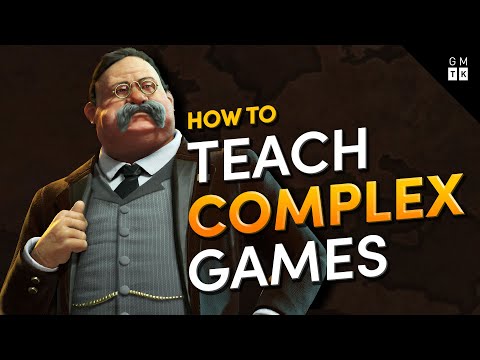Can We Make Better Tutorials for Complex Games?

I have a confession to make. I’ve tried, many times, to play games like Total War, Crusader Kings, and Endless Space. I've bought them, downloaded them, made time in my calendar for them.
And yet - the same thing always happens. I get about 20 minutes into the tutorial, and I start to zone out. My eyes glaze over, and my mind drifts. I start to think about all the things I could be doing that are more fun than this.
Like filing my taxes or watching paint dry. And this is a shame - because for the most part, video game tutorials are actually pretty good these days. They’re interwoven into the world and narrative. They’re well paced so as not to get boring.
And they’re cleverly designed to be subtle and unobtrusive. Even invisible at times. *Impact* But for certain genres like RTS, grand strategy, and city builders - let’s just call them “complex games” for this video. For these complex games, the learning experience can be pretty miserable - and at their worst, these tutorials can stop people from ever getting to the actual fun part of the game. So I wanted to find out if there were ways to improve this experience. What techniques can we take from other genres - in order to make complex games easier to teach and easier to learn? Well.
I'm Mark Brown, and this is Game Maker's Toolkit. When we look at less complex games, I think the biggest evolution has been a realisation that the tutorial doesn’t have to be something you do all in one go, before you get to play the game properly. Instead, it can be split up and sprinkled throughout the entire experience.
And this approach has many advantages. The big one is that, according to Plants vs Zombies designer George Fan - a player's willingness to learn grows along with their level of investment. So when games dump a load of tutorials on you at the start - that often exceeds your willingness to learn. By delaying these lessons, the game can wait until you're more invested. Another advantage is that you get to play the “real game” almost immediately, instead of having to sit through something that can feel boring and academic. And in fact, if each step of the tutorial is small enough - you can sometimes teach players without having a tutorial at all.
In Portal, for example, all of the early puzzle chambers are actually inferring a small piece of information about how the game works. But as far as the player is concerned, they're just playing the game. And the third benefit is that by delaying these tutorials, they can deliver messages when it's actually relevant.
The game can pop up the crafting tutorial when you first find a crafting table - instead of telling you this at the start and hoping you’ll have remembered by the time you finally get to make something. Now, complex games are typically still stuck in the old format. And that means players have to learn before they're invested, they don't get to actually play for hours, and they'll learn things that might not be relevant for ages. And, look - I can understand why this happens. The reason it's possible to delay tutorials in less complex games is that designers can slowly introduce game mechanics throughout the course of the adventure.
They can start you with a simple character with very few abilities - and then slowly increase complexity as you find new upgrades, unlock new skills, recruit new party members, and so on. But complex games typically need to begin with everything turned on. As every system talks to each other - everything needs to be online from the very beginning.
Right? Bruce Shelley, who worked with Sid Meier on the earliest Civilization games, coined the phrase “inverted pyramid of decision making”. The idea is that when you start Civilization, you basically have one decision to make on your first turn: where should you settle your city? And one decision on your next turn: what should you build there? But now you have two decisions to make. What should you do with your new unit, and what should your city build now? Soon after, those decisions start to balloon - and by the end of the game you're making dozens of decisions per turn as you juggle hundreds of units, cities, enemies, allies, and resources. The point being: over the course of a game of Civilization, the complexity has organically grown from a single settler in a foggy map - to a massive empire of competing nations.
And so by virtue of its slow increase in complexity, Civ is well placed to teach you its systems, bit by bit, as you discover them. An example of this in practice is the outstanding city builder Frostpunk. In this game you begin with one job: gathering resources by hand.
And so the game gives you a quick tutorial about that. Then you turn on the generator… and the game gives you a tutorial about that. This carries on for the entire campaign, with small tutorials for every major mechanic - but all the way you're actually playing the game for yourself.
Another avenue for this is the user interface. From my own experience, at least, a complex UI can be one of the most overwhelming things to a new player. But how many of these buttons, bars, windows, and panels need to be there on the first turn? So take a look at Mini Metro. At the beginning, there's almost no interface at all, meaning all you need to worry about is connecting up train stations. It's only when you start playing that more information slowly appears - like the train line menu, the clock, and the passenger counter. Another example can be found in Animal Crossing: New Horizons.
The tool wheel is a helpful, time-saving pinch of UI design - but it could be difficult to introduce players to two different types of inventory, at the start of the game. So, instead, you have to save up and buy the tool wheel from the shop - meaning the player gets to set the pace in terms of how complex the game's UI is. This does happen in some complex games - the UI in Total War: Troy expands as you play, for example - but I'd love to see designers get even more aggressive with this technique. So this is all about how a single campaign can become more involved over time, allowing the developers to withhold teaching until it’s actually relevant. But perhaps there's another way of thinking about this. If you want to get started with fighting games - definitely a complex genre, but that's outside the scope of this video.
Uh, if you want to try your hand at fighting games, you don’t need to know about trip guards, frame data, happy birthdays, turtling, bivouacing, or pretzel motion in your first fight. And I only made up one of those. All you need to know to get cracking is how to do more than button mash.
So the designers of Mortal Kombat 11 considered this when making the game's tutorial. They broke the player base down into segments - like couch players, dabblers, connoisseurs, and online PvPers. Then they figured out what people actually need to know, depending on what level of player they are - and put those lessons into three tutorial brackets: basics, advanced, and strategy. The important part is that these three brackets aren't designed to be played all in one go. Instead, the tutorial is specifically designed to kick you out of the tutorial menu at the end of each segment - with the intention that you will now go and play the game, use what you learned, and enjoy yourself.
You can always come back and learn more when you feel ready to go to the next level - and take your game from button mashing to bivouacing. Oh wait that's the one I made up. Anyway. Here's my point. Most complex games aren't meant to be played though just once, like a story-driven adventure game. They're designed to be played over and over again - like a fighting game.
And so perhaps we can take this format, but instead of thinking about peppering tutorials across a single campaign - we can zoom out and put tutorials in between entire playthroughs of the campaign. And I've got a story that could show how this might work. My first game in the Civilization series was Civilization V - which was well received, but some hardcore fans criticised it for simplifying or outright removing features that had been seen in earlier entries. Stuff like espionage and religion. But it was great for me because it was so much easier to learn a game with fewer systems. I was able to get into the fun relatively quickly, and actually play through a few campaigns.
Later down the line, Firaxis would eventually reintroduce those forgotten features - and more - in expansion packs like Gods & Kings and Brave New World. And I found those pretty easy to learn as well because I already knew the basics from Civ V: I just needed to figure out the new stuff. And so these expansion packs essentially created that gradual increase of complexity I've been talking about - just with entire campaigns in between the tutorials.
And so the same could be done for other games - just, not necessarily through selling expansion packs. What I mean is: instead of an easy mode just being the same game but with dumb AI - it could be a stripped back version of the game with fewer systems to know about. Then the player can play again, with more systems turned on. And keep going until they get to the full fat version of the game.
I'm not saying it would be easy to do - and the game would have to be designed this way from the very beginning. But, if done well, it could be very effective at teaching players as their investment rises. But okay. Maybe it doesn't make sense for a certain game to sprinkle the tutorial out across multiple turns or multiple campaigns. Perhaps the design just doesn't accommodate that and it actually does need to frontload the experience with a big load of learning. Fair enough.
So - is there some way that we can make this more interesting, more fun, and more effective at teaching people the basics? Something we see in almost every action game tutorial is a bit where the game asks you to perform the action you're being taught. Like, you can't move on until you punch six people. It's a simple but effective way of teaching because you're asking the player to get hands-on and try for themselves. We call this kinaesthetic learning - which is where deep learning occurs via the process of physically doing a task. Now - complex games do try and do this. You've probably played games where it walks you through a sample campaign by pointing arrows at bits of the UI and asking you to click here, click there, select this, drag that.
And, well… you're involved! You're doing stuff! Aren't you clever? But are they actually that effective? I'm not so sure. Asher Vollmer, who made the elegant mobile puzzler Threes, says of these arrows - "As far as the game is concerned; I have advanced. But as far as my brain is concerned; I've learned nothing". Part of the problem is that blindly following instructions just isn’t a very effective way to learn. So, in Asher’s game, he instead turns the tutorial into a series of very small and simple puzzles for the player to figure out. Take, for example, this bit, which is about telling you how to use the outside walls to rearrange tiles.
He could ask players to “swipe to the left twice”. And now "swipe up twice". But he doesn't: he says "Rearrange numbers by pushing 'em into walls" and then "use the walls to add 1 & 2 together". It's a very simple task, but it's enough for players to actually engage their brain and start to do the sort of thinking that will be used in the proper game. Luckily, some complex games do a really good job of this.
If we look at the first tutorial in Frontier's Planet Zoo, the game starts by walking you through the process of improving an animal’s welfare. NANCY: "Aww, poor dabs! I'm sure it can't have escaped your attention that the tigers look a bit miffed. That's because they aren't too keen on the type of terrain in their habitat". It’s pretty hand hold-y and straightforward. But then it asks you to improve the overall welfare of all the animals in the park. NANCY: "All of that should give you a pretty good understanding of how to make animals happy, so I'd like you to go check on all the other animals in the zoo and fix up any issues with their habitats."
And it just lets you get on with it. At this point you're given hardly any guidance, so you have to put into practice what you just learned - and do some critical thinking to fill in the gaps in your knowledge. NANCY: "Right! I'm off for a cuppa while you make sure all the animals are well looked after!" I found this really effective, and it happens throughout the tutorial. You're put into zoos with specific problems, shown how to fix one of them, and then you're asked to solve the rest on your own. Offworld Trading Company is another good example - in each step of the tutorial you are given a list of objectives and have to solve them for yourself.
Simply by removing the “click here” arrow and making the player find the right option themselves is enough to make them feel engaged. And it feels like you're actually playing a game, right from the word go. But I won't pretend that this is a perfect solution. And that's because of feedback. When we learn kinaesthetically, we use feedback to see if we did it right or wrong.
Now, if you make a mistake in an action game you’ll see that immediately. But, in a strategy game, if you don’t balance your economy correctly you might not realise for many hours. Complex games typically have a very slow feedback cycle, which does make it hard to learn from hands-on experience.
You may need to play an entire campaign to understand how decisions and strategies will unfold over the whole game. Which is why the easiest games to learn are those with short campaigns that you can repeat often - compared to those that last hours and hours. But there are some potential solutions to this.
Perhaps the quick game in Civilization, which dramatically speeds up the campaign, could be rebranded as a training tool? Another answer is for these tutorials to use advisor characters who can warn you if you're doing something dumb that might have a negative effect down the line. In Offworld I got told off for selling aluminium for less than $10 a pop, and got a lesson in how the stock market works. The nice thing is: these two solutions also help with another problem that strategy game tutorials face. Which is this: it's pretty teach to people how to do things - but it's much harder to explain why to do them.
I can tell you which buttons to press to build something in Civilization, but there's no simple way to explain what you should build, or when you should build it, or where you should place it after it's built. So - like before, speeding up the feedback cycle allows players to see the consequences of those choices for themselves. And advisor characters can offer recommendations and warnings. ECONOMIC ADVISOR: "I think we have enough workers for the moment.
You may want to construct something else in your city". There's one more thing that games do, that make them easier to learn. And that's leveraging things that people are already familiar with. You know: spikes hurt, ice is slippery. Coins let you buy things, keys open locks. Skulls mean danger, and so on.
Plants vs Zombies doesn't need to tell you that a zombie with a metal bucket on its head is more resilient than one with a plastic cone. We know how these materials work in real life. By leaning on stuff that players already know, games can feel intuitive to play - and it often means they don't require a tutorial at all.
Now over in the world of complex games - one way to do this is to use a theme that is grounded or historical. Civilisation is definitely a franchise that uses this to its advantage. People can bring their own knowledge of history to make assumptions about how things will work.
Most of the time. But perhaps the best place for complex games to look for real world inspiration is in the user interfaces we encounter every day. Just like how Reigns copies the swipe left, swipe right interaction from dating apps like Tinder. And how Disco Elysium's dialogue boxes are inspired by a Twitter feed. So let's see all this in action and go back to that bit in Planet Zoo where I was left to improve the animals' welfare on my own. How did I know what to do? Well, I know that I can sort this list by welfare by clicking up here... because thats
how a list works on most websites. And I know I can click this to find the animal because the same icon is used on Google Maps. I can easily see where the problem lies, because red indicates bad and green indicates good.
I know how to filter the items because the funnel icon is used on apps like Google Sheets - though I could probably make some assumptions for what an animal wants just by my knowledge of real-world critters. On the flip side, here's an example of this going very wrong. In playtests for Total War: Troy, some players really struggled to find the end turn button. One player spent 40 minutes on the first turn, unsure how to move on.
The culprit? This button, which uses an hourglass to indicate "end turn". Now, people who have been playing strategy games for years might associate an hourglass with ending a turn - but I think most people have a stronger association with something loading, including the cursor in old versions of Windows. By the way, these loading animations are called "Throbbers" and I'm really sorry to be the one to have to tell you this. Anyway - the devs swapped it for an arrow before launch. And I think we can take two lessons from this.
One: don't assume your audience has played other games. And two: play test your tutorials. Like, a lot. So there are a few more techniques I want to touch on before I wrap up. We all know the idiom "show, don't tell" - and it applies to tutorial design too.
Massive walls of text can be hard to get through - and an image or video can sometimes tell you the same information in half the time. Take these preview windows for weapons in Into the Breach. Designer Justin Ma said “You could type out a hundred times, ‘Damages a tile and pushes adjacent tiles,’ but showing that little animation of them moving is a thousand times more effective". Now, sure - text is almost always necessary in the tutorial for a complex game. But designers should try to cut down words, be consistent with language, avoid jargon, and… maybe this is just a personal preference… but I don’t really like this thing where some pointless flavour text is spoken by a voice actor but the actual important stuff is left unsaid.
HOMER: "March north-west, towards the land of Corinth. For even now, the Corinthians plot your demise". Another good technique is to provide ways for players to find information when they get stuck. Things like tool tips - and tool tips within tool tips.
An encyclopaedia of terms and the ability to rewind or replay specific bits of the tutorial. Ultimately, if someone gets stuck you don't want their only solution to be Google. Plus, this should give you more confidence to let players figure stuff out on their own, as the information will be there if they need it.
And finally, it's good to remember that people learn in different ways. I won't deny that some of the ideas in this video are biased by the fact that I am personally a very kinaesthetic and visual learner. And I have the attention span of a six year old child. So providing multiple avenues can be good. Offworld, for example, has two ways to learn - scripted tutorials that walk you through each step, and practice challenges where you can learn through trial-and-error. Meanwhile, Total War is always good at providing different tutorials for complete newbies and returning players who just want to figure out the new stuff.
Just like with the user interface in the last episode of GMTK, the tutorial can be one of those things that's undervalued, and left until the last moment. But, again: it shouldn't be ignored because a tutorial can be so important to a game's success. For this video I spoke to developers at places like Paradox and Creative Assembly and everyone told me the same thing: teaching new people how to play is the only way for a franchise to grow its fanbase - and avoid withering into irrelevance. In this video, I've identified some techniques that I think could make tutorials better: Finding ways to break the tutorial up - either across a campaign, or across multiple campaigns.
Finding ways to have the player get their hands on the system and learn by doing, rather than reading. And finding ways to be intuitive, familiar, and welcoming. Thankfully, strides are being made in this area, with more thoughtful tutorials and more intuitive interfaces. But there's still a lot of work to be done. Until I can get through the Crusader Kings tutorial without falling asleep, we're not quite there. Thanks for watching.
If you like what you just saw and want to show your appreciation, please check out this quick YouTube ad break. Stick around afterwards for an indie game recommendation. My recommendation this time is Narita Boy - a trippy, retro-tinged brawler with a killer pixel art aesthetic. It's a minor Metroidvania with a bigger focus on fight scenes: which reminds me of Guacamelee.
And the strange, esoteric plot makes me think of Sword & Sworcery. The game's not without its problems - including a floaty jump and simplistic level design - but I just found the whole thing enchanting and utterly engrossing. Nartia Boy's on everything - including Xbox Game Pass.
2021-06-02 00:35


